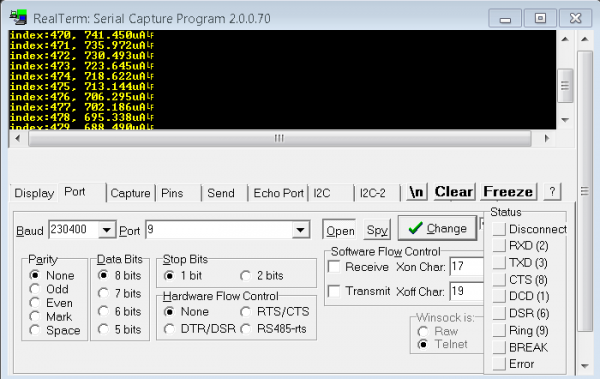This example will use EVAL-ADICUP3029 and EVAL_AD5940ELCZ to carry out a square wave voltammetry measurement. Note, the corresponding application example in the SDK is the AD5940_SqrWveVoltammetry project.
Square wave voltammetry is an electrochemical technique where the voltage between the reference and sense electrode is incremented in a square wave fashion as in figure below. The response current on the working electrode is measured after each half step.

For more details refer to the application note, AN-1563.
The following is a list of items required to carry out the measurement.

The source code and include files for the project can be found on Git
The source code and include files of the AD5940_SqrWveVoltammetry can be found in the SDK below:
To compile and run the example open the project in either Keil or IAR. The AD5940RampStructInit() function is used to configure the main application parameters that control the excitation signal and the data acquisition. The parameters and their description are explained in the table below:
| Variable Name in Firmware . | Name on diagram | Description |
|---|---|---|
| RampStartVolt | E1 | This variable sets the voltage at which the excitation signal begins |
| RampPeakVolt | E2 | This sets the peak voltage of the signal. T |
| VzeroStart | This sets the start voltage of Vzero. Optimully set to 1.3V. The Actual start voltage on the sensor pin is VzeroStart + RampStartVolt | |
| VzeroPeak | This sets the peak voltage of Vzero. Optimully set to 1.3V. The Actual peak voltage on the sensor pin is VzeroPeak + RampPeakVolt | |
| Frequency | Frequency | This sets the frequency of the square wave signal |
| SqrWvAmplitude | Ep | This sets the amplitude of the square wave signal |
| SqrWvIncrement | Estep | This sets the increment voltage step after each square wave |
| SampleDelay | t | This variable sets the duration from when the step is applied to when the ADC measures the response current. Note, the SampleDelay must be shorter than the total step width. There are no checks in firmware. |

The measurement results are sent to the PC via UART. To establish connection over UART, connect the Micro-USB cable to the PC and to the EVAL-ADICUP3029 board. A terminal program such as RealTerm or Putty is required to display the results
Following is the UART configuration.
Select COM Port Baud rate: 230400 Data: 8 bit Parity: none Stop: 1 bit Flow Control: none
The data on the terminal indicates the index number of the data point and the current measured in µA.
